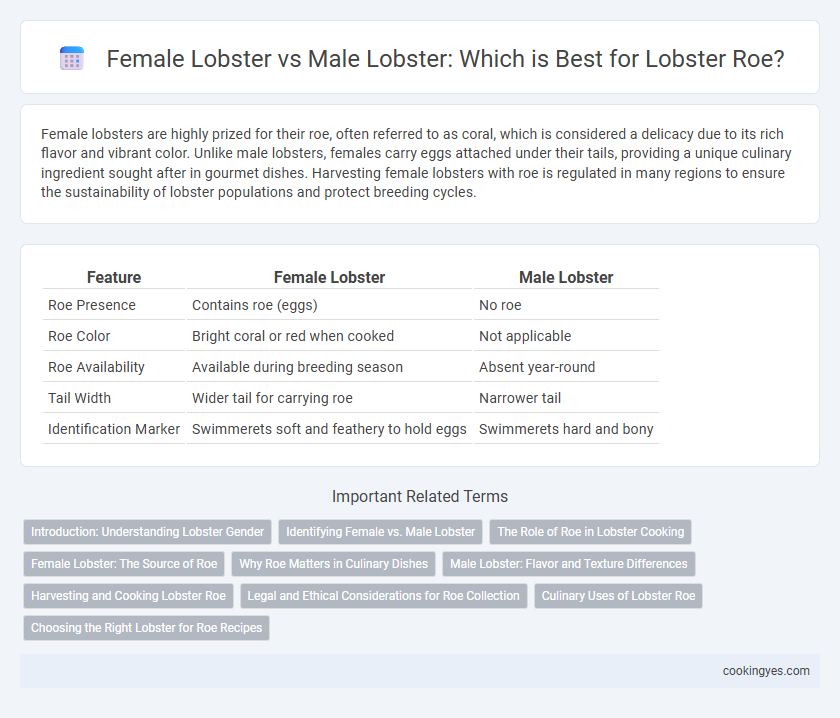Female lobsters are highly prized for their roe, often referred to as coral, which is considered a delicacy due to its rich flavor and vibrant color. Unlike male lobsters, females carry eggs attached under their tails, providing a unique culinary ingredient sought after in gourmet dishes. Harvesting female lobsters with roe is regulated in many regions to ensure the sustainability of lobster populations and protect breeding cycles.
Table of Comparison
| Feature | Female Lobster | Male Lobster |
|---|---|---|
| Roe Presence | Contains roe (eggs) | No roe |
| Roe Color | Bright coral or red when cooked | Not applicable |
| Roe Availability | Available during breeding season | Absent year-round |
| Tail Width | Wider tail for carrying roe | Narrower tail |
| Identification Marker | Swimmerets soft and feathery to hold eggs | Swimmerets hard and bony |
Introduction: Understanding Lobster Gender
Female lobsters are identified by wider, flatter tails designed for carrying roe, which is highly prized in culinary applications and often sought after for its rich texture and flavor. In contrast, male lobsters have narrower, more cylindrical tails and lack roe, making them less valuable for reproduction-related seafood delicacies. Understanding these gender differences is crucial for sustainable harvesting and maximizing the yield of lobster roe in fisheries.
Identifying Female vs. Male Lobster
Female lobsters can be identified by their wider, more rounded swimmerets located directly behind the last pair of walking legs, which are soft and feathery to carry roe, while male lobsters have harder, more rigid swimmerets used for mating. The underside of the first pair of swimmerets on female lobsters tends to be larger and less pointed compared to males. Male lobsters often have larger claws and a narrower tail, whereas females typically display a broader abdomen to accommodate egg development and roe production.
The Role of Roe in Lobster Cooking
Female lobsters produce roe, also known as coral, which is highly prized in lobster cooking for its rich flavor and vibrant color. The roe enhances the culinary experience by adding a distinct texture and a delicate, briny taste that complements the sweet lobster meat. Unlike males, female lobsters with roe offer an exclusive ingredient that chefs often incorporate into sauces, bisques, and gourmet dishes.
Female Lobster: The Source of Roe
Female lobsters are the primary source of lobster roe, which appears as bright orange clusters attached to the underside of their tails during the breeding season. These roe, often called coral, are highly prized for their rich flavor and delicate texture, contrasting with the more commonly consumed claw and tail meat. Unlike males, female lobsters are harvested selectively to allow for sustainable population management, ensuring the continued availability of both lobster meat and roe in the market.
Why Roe Matters in Culinary Dishes
Female lobsters carry roe, which are highly prized in culinary dishes for their delicate texture and rich flavor, enhancing seafood recipes with a unique taste profile. Roe's vibrant orange color signals freshness and quality, making it a sought-after ingredient in gourmet cooking, especially in coastal cuisine. The nutritional benefits of lobster roe, including high protein and omega-3 fatty acids, contribute to its status as a luxury delicacy compared to male lobster meat.
Male Lobster: Flavor and Texture Differences
Male lobster meat is often firmer and denser compared to female lobster, offering a more robust texture preferred by many seafood enthusiasts. While female lobsters are prized for their roe, male lobsters provide a richer and sweeter flavor profile in the tail and claw meat. The difference in muscle composition between male and female lobsters directly influences the taste and mouthfeel, making male lobster meat a favored choice for grilling and boiling.
Harvesting and Cooking Lobster Roe
Female lobsters are prized for their roe, which is harvested when the lobster is cooked just before or during egg-bearing season, typically between late summer and early fall. The bright red roe, found beneath the tail, is delicate and considered a delicacy, often used to enhance sauces or served on its own. Male lobsters do not produce roe, making female lobsters the primary choice for culinary dishes that highlight lobster eggs.
Legal and Ethical Considerations for Roe Collection
Female lobsters with eggs, known as roe, are subject to strict legal protections in many regions to prevent overharvesting and ensure sustainable populations. Ethical considerations emphasize avoiding the collection of roe from berried females, as their eggs are vital for lobster reproduction and ecosystem balance. Fisheries management often enforces size limits, seasonal closures, and specific handling practices to safeguard female lobsters carrying roe.
Culinary Uses of Lobster Roe
Female lobsters are prized in culinary arts for their roe, known as coral, which enhances flavor and color in dishes like lobster bisque and sauces. Lobster roe has a rich, briny taste and a vibrant red-orange hue that adds both visual appeal and depth of flavor, distinguishing it from the milder meat of male lobsters. Chefs often seek female lobsters specifically to harvest this roe, elevating gourmet recipes with its unique texture and taste.
Choosing the Right Lobster for Roe Recipes
Female lobsters are preferred for roe recipes due to their bright orange, edible eggs known as coral, which add rich flavor and vibrant color to dishes. Male lobsters lack roe, making them unsuitable for recipes requiring lobster eggs. Selecting a large, healthy female lobster increases the likelihood of abundant roe, enhancing the culinary experience in roe-based lobster dishes.
Female lobster vs male lobster for roe Infographic

 cookingyes.com
cookingyes.com